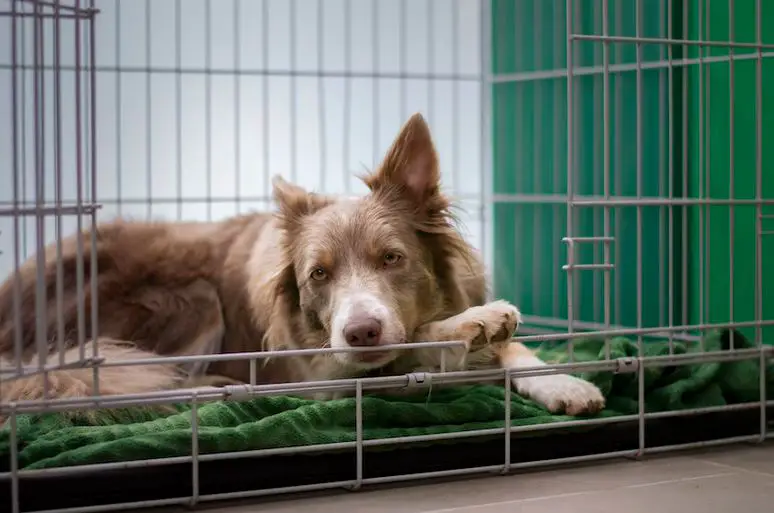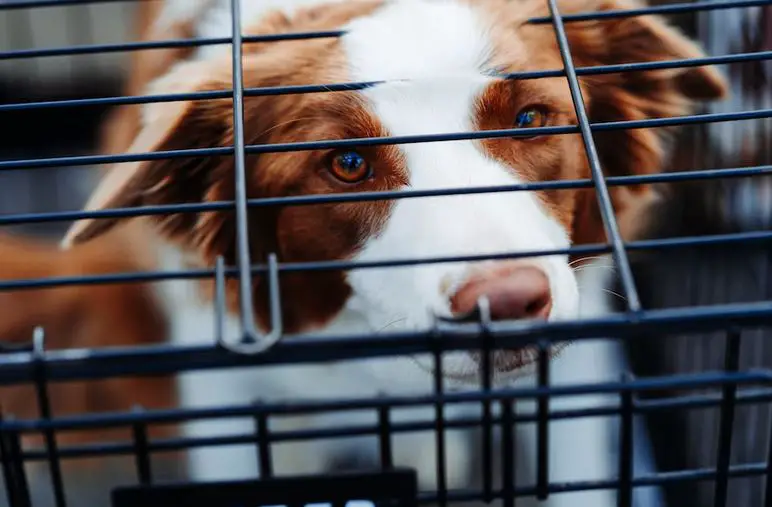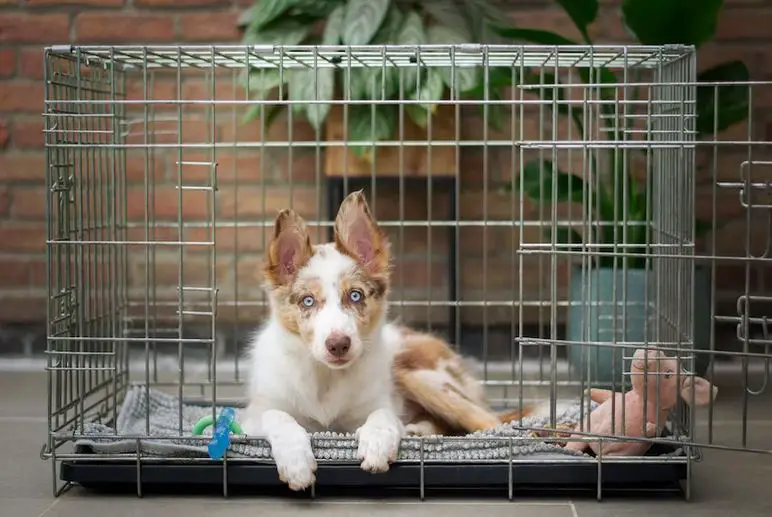Just like little kids, puppies often make a big fuss about their food. And sometimes they won’t eat, especially when they’re stuck in their crate.
If you are wondering why your dog won’t eat treats in the crate, this post is for you.
I’ll walk you through some of the reasons why a dog won’t eat treats in the crate and what you could do to make them eat treats while they in their crate.
Why Dogs Won’t Eat Treats In Crate?
There are a number of reasons why your beloved pooch might refuse to eat inside its crate. Let’s take a look at the most common ones:

Your Puppy Might Be Stressed
Your dog might be suffering from stress and anxiety. Even though a crate is designed to address all of these issues, some dogs may find it terrifying, especially if they are not properly crate trained yet.
The problem here might be your dog’s psychological issues. It might be experiencing fear, separation anxiety, etc…
A dog won’t eat or drink normally when it is gripped with dread. Be aware that, if not addressed properly, fear can also lead to other behavioural issues.
Your home’s strange surroundings can potentially frighten your dog, so if you just brought your puppy home, you should give them some time to unwind.
Your Puppy Doesn’t Like The Treats
It’s possible that your dog simply dislikes the treats you’re giving him. Your dog won’t eat it the same whether you put it inside or outside the crate.
Also Read: Best treats for cane corso
Finding out what your dog prefers is important because different dogs have different preferences. If you want to find something your dog loves, you might need to test out a few different treats.
The Puppy’s Crate Might Be Dirty
Don’t forget to make sure that the crate is clean before putting your pup in there. A dirty crate can really mess with their mood and appetite.
While some dogs don’t mind eating treats in unclean conditions, others are finicky. If you think this is the case, make sure to keep your dog’s box clean.
Additionally, your dog should never share its crate with another animal. In doing so, the other animal’s odour will cling to the crate and affect the behaviour of your dog.
Also Read: How to clean a dog bed
This is due to dogs’ strong territorial instincts. Their defences will be up and they might not eat if they scent another animal in their crate.
Your Puppy Might Be Sick
Regardless of whether they are inside or outside of the crate, dogs with health issues will stop eating treats or anything else.

If your dog won’t eat anything, it is best to bring your dog to the veterinarian for a thorough evaluation because certain health issues might be dangerous.
A general sign for a wide range of medical conditions is a lack of appetite. Your dog may be suffering from something as minor as an upset stomach or something more serious like cancer or kidney failure.
You can only learn your pet’s exact condition from the veterinarian. Plus, your pet cannot be treated until a proper diagnosis has been made. Please take this seriously because if your dog is left untreated, it can actually starve itself to death.
The Crate May Be Too Small
The size of the crate is another factor you should think about. Your dog might not be able to fully stand up to eat properly if it’s too little.
Dogs grow really fast in size in the first few weeks. Because of this, you need to be careful about the crate size you choose. It should always be the same size as your dog as an adult.
Other Reasons
Sometimes your dog might not be interested in eating treats while they are in their crate. It could be because they’re not hungry or even because they are focused on something else, like trying to escape from the crate.
This is really common in dogs that were just brought home.
How To Get My Dog To Eat Treats In The Crate?
Let me give you a few tips you can do to make things easier for your puppy.
Get A Proper Sized Crate
Pooches grow really fast and a crate designed for puppies may not fit them anymore.
If it looks like your dog is getting too big for its crate, you should upgrade to a bigger one that’s preferably 1.5 times larger than your puppy’s adult size. Your dog will have plenty of space in this larger crate to stand and roam around, which means it will have enough room to comfortably devour its meals.
Also Read: Best dog crates for mastiffs
The good news is that crate makers often specify the correct crate size that corresponds to the particular breed. Moreover, there are modular-type crates that you can buy where you can expand or reduce in size accordingly.

If size isn’t the issue, read through the rest.
Clean The Crate Regularly
Keeping your dog’s crate clean is super important. If it’s clean your dog will never experience appetite issues like this one. Plus, it prevents infections.
Generally speaking, you should clean your dog’s crate every four weeks. However, maintenance might be performed every two weeks if it’s becoming more filthy quickly.
Avoid using powerful detergents while washing the crate. Enzymatic cleaners should ideally only be used to get rid of odours and stubborn filth.
If you have a young puppy, something I would like to recommend is using a pee pad. Even if you are not cleaning the crate, you should wash the fabric stuff once a week.
Try Changing The Location Of The Crate
You can try putting your dog’s crate in a different area if it is tidy and the right size. Pick a location that sees the least amount of foot traffic and is quiet.
It’s preferable to keep dogs’ crates within a quiet area when they are first brought home. The dog will be able to settle in and eat peacefully as a result.
Additionally, consider placing a blanket over the crate when you give treats to your dog. Your furry friend will feel more secure and will aid in proper feeding.
Make The Dog Feel More Comfortable In The Crate
Because they dislike the confinement, some dogs refuse to eat treats inside a crate. Training your dog to develop good connections with the crate is the answer to this problem.
Always be patient and keep in mind that every dog learns at a different rate. Don’t be afraid to seek the advice of a qualified dog trainer if your efforts aren’t having the desired effect.
Try Giving Your Dog A Different Treat
You can also try switching your dog’s treats to see if that sparks its appetite again. Think about trying a different flavour to see whether your pet will enjoy it.
Maybe even give your dog some freezer burned meat if you have some meat that’s been sitting in your freezer for a while.
Just like small children, puppies can also be picky about their food. Since fish-based dog treats have a richer flavour and aroma, the majority of them prefer it. Overall, it takes some trial and error to find a good treat for your fussy dog.
You might need to test out 3-5 different types of treats.
Bottom Line
There are few things that can be done if your dog refuses to eat treats while in the crate, but if you think your pet may have a health issue, you should always consult a vet right away.
Always be patient and employ constructive techniques. Keep in mind that using violence won’t make a fearful dog eat.
